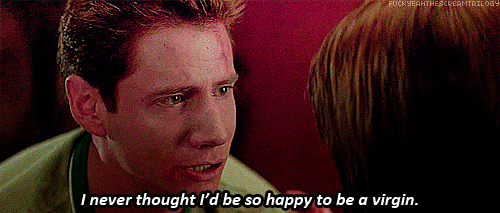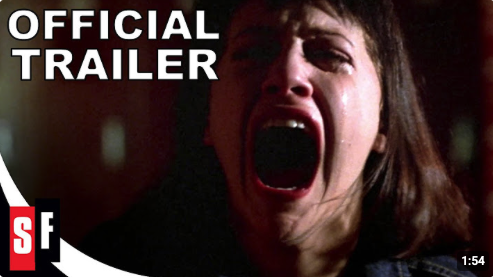The dangers of hook-up culture 🦠
Hey, horror hottie.
Last year, we explored the relationship between purity and survival in horror, and today I want to get a bit more intimate with the topic.
We’ll be getting under the sheets with the idea of horror film sex as a death sentence. We’re not talking ‘terror at make-out point’ kinda stuff, but how different types of sexual ‘contamination’ serve a purity-policing purpose.
Grab your coat and call a taxi; we’re about to get busy…
Horror & sex: the ultimate bedfellows
Horror and sex have a long and fruitful relationship. Whether it's a demon, a virus, or a curse, horror films use different forms of sexual contamination to enforce the idea that an act of desire or sexual freedom warrants punishment.

As if many of these films realise a sex act isn't really enough to incur such a violent end, we'll often see horror film characters committing their lustful 'crime' alongside an array of other delinquent acts, like theft, vandalism, breaking and entering, intoxication, and all that other fun stuff. Each crime serves as a tool to help the audience distance themselves from the humanity of the character, allowing us guilt-free enjoyment of the horrors to come.
The contamination could be supernatural, biological, or psychological, but the message remains the same: sexual purity equals survival, and contamination equals death. It’s moral judgement disguised as bodily horror.
It Follows
I’d be remiss if I didn’t start with the most obvious sexual contamination horror, It Follows. It’s a compelling exploration of informed consent and the life-altering effects of sexual assault as an invisible, inescapable threat that leaves lasting paranoia in its wake.
Jay (Maika Monroe) loses her virginity to new boyfriend Hugh (Jake Weary), who promptly holds a chloroform-soaked cloth over her face, knocking her out. Jay wakes up tied to a wheelchair in her underwear in an abandoned car park. Using this (heavy-handed) method, Hugh reveals that Jay will now be followed by a shapeshifting paranormal entity that will kill her if it touches her. The only way to pass it on is through intercourse, but if your victim is killed by the entity, it defaults back to you. This continues back down the line of infected.

In an article for Bloody Disgusting, Brendan Morrow says, “Even though the sex was consensual, the image of Hugh knocking Jay out certainly calls rape to mind, and besides, could Jay really give consent without having any knowledge of the creature? The ensuing visuals of Jay being dropped home half-naked, getting questioned by police, staying at the hospital, and laying in bed depressed for days, hammer the point home. Upon arriving back at the house, Jay spends a lot of time staring at herself in the mirror, examining the body that has been violated by an intruder.”
He concludes that, “Once you have been violated, there is no easy fix. It will be with you forever.” Whether read as an STI metaphor (which is the most popular reading) or a sexual assault allegory, It Follows demonstrates how horror punishes sexual agency itself. The moment Jay steps outside traditional boundaries of 'pure' intimacy, she pays the price.
Near Dark
Near Dark (1987) is a particularly potent offering in the ‘purity policing’ genre because its release date and themes can be closely linked to the HIV/AIDS epidemic. Originally called “Gay Men’s Pneumonia”, AIDS (Acquired Immunodeficiency Syndrome) was first officially reported in the US in 1981. Because of the communities it disproportionately affected (gay men, people with an addiction, sex workers, and minorities), AIDS quickly came to have negative associations as an ‘unclean’ disease. Public panic reached fever pitch by 1985, and by Near Dark’s release in 1987, AIDS was considered “the most urgent health problem facing the world.”

Whether it means to or not, Near Dark touches on similar fears through the lens of vampiric infection. Humble midwestern farmer Caleb Colton (Adrian Pasdar) hooks up with out-of-towner Mae (Jenny Wright), who bites him during their steamy sesh. She’s revealed to be part of a roving band of hooligan vampires who have formed their own family of sorts. Caleb’s real family manage to cure him with a full blood transfusion, saving him from a life on the fringes of society, being slowly killed by infected blood.
It’s near impossible not to draw parallels between the symptoms Caleb experiences through his sexually transmitted blood infection and those of AIDS. The attitudes expressed towards the vampires, their affliction, and their way of life closely mirror the public’s misguided view of people living with AIDS. Not to mention the fact that a wholesome American family unit and a commitment to clean living provided the cure to the sexually transmitted contamination of vampirism.
Cherry Falls
Here’s where I pull an Uno reverse card on you, peach. Cherry Falls (1999) turns decades of purity-based horror tropes on its head by killing virgins. Yup! Sexual conformity gone mad — rather than championing the purest, it wants its survivors good and dirty.
In the small Virginian (👀) town of Cherry Falls, a couple are killed at make-out point; the killer carves the word ‘virgin’ into each of the victims. The town is rocked, but more so when the next victim is attacked in her own home. The town sheriff’s daughter, Jody (Brittany Murphy), soon uncovers a dark truth connected to the killings involving the rape of an introverted high school girl that had been dismissed 25 years earlier.

Purity is the killer's motivation; deliberately going for the pure, wealthy children of the town to seek revenge. But here's the kicker — the film still seeks to control sexual autonomy, just from the flip side. It’s still an external force using the threat of violence to dictate the sexual behaviours of the youth. Cherry Falls suggests that horror's sexual policing was never really about protecting purity — it was always about controlling sexual agency.
Horror's dirtiest little secret isn't the gore or the jump scares; it's the way these films weaponise our deepest anxieties about sex and moral purity. The message is clear: in horror, pleasure, and sexual autonomy come at a price.
I’d love to hear your thoughts. Hit reply to this email or share it with someone you think would dig it.🪦